Research on Influencing Factors of Cable Clamp Bolt Elastic Interaction in Cross-Ocean Suspension Bridges
Abstract
:1. Introduction
2. Theoretical Analysis
3. Full-Scale Experiment
3.1. Experiment Setup
3.2. Loading and Data Collection
4. Finite Element Analysis
4.1. Finite Element Model Establishment
4.2. Finite Element Model Verification
5. Influencing Factors of the Elastic Interaction
5.1. Main Cable Material Properties
5.2. Cable Clamp Design Parameters
5.2.1. Bolt Distance
5.2.2. Number of Bolts
5.3. Tightening Method
5.3.1. Preload of Bolt Installation
5.3.2. Bolt Tightening Sequence
6. Discussion
7. Conclusions
- (1)
- From the theoretical model, when other parameters are the same, larger bolt diameter, smaller bolt clamping section length, lower main cable stiffness, and larger preload result in more obvious elastic interaction of the bolts.
- (2)
- The average preload loss was reduced by approximately 27% when the elastic modulus was increased by approximately 110%. The elastic interaction of the bolt decreases as the elastic modulus of the main cable increases. In the design of cable clamps, the elastic modulus of the main cable should be increased appropriately.
- (3)
- The average preload loss was reduced by approximately 45% when the bolt center distance was increased by 75%. The elastic interaction of the bolts decreases as the bolt center distance increases. In the design of the cable clamp, the center distance of the bolt should be increased appropriately.
- (4)
- The number of bolts affects the elastic interaction to a minor degree. In actual engineering, the influence of the number of bolts on the elastic interaction can be ignored.
- (5)
- When the bolt installation preload was increased by 133%, the average preload loss was reduced by approximately 125%, which was almost a linear relationship. When the installation preload increases, the elastic interaction becomes more obvious. In the process of bolt tightening, the installation preload should be selected moderately to ensure that the bolt preload reaches a standard and uniform distribution.
- (6)
- Among the four fastening sequences researched, the sequence of tightening from the center as in case 3 produces the most obvious elastic interactions. Therefore, when tightening the bolts, try to avoid tightening from the center bolt first.
Author Contributions
Funding
Institutional Review Board Statement
Informed Consent Statement
Data Availability Statement
Conflicts of Interest
References
- Bibel, G.D. Experimental and analytical study of elastic interaction in a pipe flange. In Proceedings of the International Conference on Pressure Vessel Technology, Dusseldorf, Germany, 21–25 September 1992. [Google Scholar]
- Bibel, G.D.; Ezell, R.M. An improved flange bolt-up procedure using experimentally determined elastic interaction coefficients. J. Press. Vessel Technol. 1992, 439, 443. [Google Scholar] [CrossRef]
- Li, Y.; Liu, Z.; Wang, Y.; Cai, L.; Xu, W. Research on preload of bolted joints tightening sequence-related relaxation considering elastic interaction between bolts. J. Constr. Steel Res. 2019, 160, 45–53. [Google Scholar] [CrossRef]
- Alkelani, A.A.; Nassar, S.A.; Housari, B.A. Formulation of elastic interaction between Boltsduring the tightening of flatface gasketed joints. J. Mech. Des. 2009, 131, 021004. [Google Scholar] [CrossRef]
- Nassar, S.A.; Yang, X. Novel formulation of bolt elastic interaction in gasketed joints. J. Press. Vessel Technol. 2009, 131, 051204. [Google Scholar] [CrossRef]
- Zuo, W.; Liu, Z.; Zhao, Y.; Niu, N.; Zheng, M. Research on the tightening strategy of bolted flange for contact stiffness of joint surface. Struct. Eng. Mech. 2022, 83, 341. [Google Scholar]
- Jiang, K.; Liu, Z.; Yang, C.; Zhang, C.; Tian, Y.; Zhang, T. Effects of the joint surface considering asperity interaction on the bolted joint performance in the bolt tightening process. Tribol. Int. 2022, 167, 107408. [Google Scholar] [CrossRef]
- Liu, Z.; Chen, W.; Yan, X.; Zheng, M.; Li, M.; Li, Y. Research on movement of dimensional singularities without elastic interaction in gasketed joints. Structures 2024, 61, 106088. [Google Scholar] [CrossRef]
- Takaki, T.; Fukuoka, T. Effective bolting up procedure using finite element analysis and elastic interaction coefficient method. In Proceedings of the ASME Pressure Vessels and Piping Conference, San Diego, CA, USA, 25–29 July 2004; Volume 46733, pp. 155–162. [Google Scholar]
- Bouzid, A.H.; Galai, H. A new approach to model bolted flange joints with full face gaskets. J. Press. Vessel Technol. 2011, 133, 021203. [Google Scholar] [CrossRef]
- Yuan, S.; Zhang, Y.; Fan, Y.; Zhang, Y. A method to achieve uniform clamp force in a bolted rotor with curvic couplings. Proc. Inst. Mech. Eng. Part E J. Process Mech. Eng. 2016, 230, 335–344. [Google Scholar] [CrossRef]
- Zhu, L.; Bouzid, A.H.; Hong, J. Numerical and experimental study of elastic interact-ion in bolted flange joints. J. Press. Vessel. Technol. 2017, 139, 021211. [Google Scholar] [CrossRef]
- Zhu, L.; Bouzid, A.H.; Hong, J.; Zhang, Z. Elastic interaction in bolted flange joints: An analytical model to predict and optimize bolt load. J. Press. Vessel Technol. 2018, 140, 041202. [Google Scholar] [CrossRef]
- Zhu, L.; Bouzid, A.H.; Hong, J. Analytical evaluation of elastic interaction in bolted flange joints. Int. J. Press. Vessel Pip. 2018, 165, 176–184. [Google Scholar] [CrossRef]
- Abasolo, M.; Aguirrebeitia, J.; Avilés, R.; Fernández de Bustos, I. A tetraparametric metamodel for the analysis and design of bolting sequences for wind generator flanges. J. Press. Vessel Technol. 2011, 133, 041202. [Google Scholar] [CrossRef]
- Abasolo, M.; Aguirrebeitia, J.; Avilés, R.; Fernández de Bustos, I. Methodology for the optimization of bolting sequences for wind generator flanges. J. Press. Vessel Technol. 2014, 136, 061202. [Google Scholar] [CrossRef]
- Wang, Y.Q.; Wu, J.K.; Liu, H.B.; Kuang, K.; Cui, X.W.; Han, L.S. Analysis of elastic interaction stiffness and its effect on bolt preloading. Int. J. Mech. Sci. 2017, 130, 307–314. [Google Scholar] [CrossRef]
- Coria, I.; Abasolo, M.; Olaskoaga, I.; Etxezarreta, A.; Aguirrebeitia, J. A new methodology for the optimization of bolt tightening sequences for ring type joints. Ocean. Eng. 2017, 129, 441–450. [Google Scholar] [CrossRef]
- Coria, I.; Abasolo, M.; Aguirrebeitia, J.; Fernández de Bustos, I. Generalization of the tetraparametric as-sembly method for the optimization of bolt tightening sequences in ring-type joints. Proc. Inst. Mech. Eng. Part E J. Process Mech. Eng. 2019, 233, 991–1000. [Google Scholar] [CrossRef]
- Huang, H.; Wang, Y.; Wei, T.; Yao, J.; Xue, W. Study of preload relaxation and optimization of wind turbine bolted connections based on the improved elastic interaction coefficient method. Proc. Inst. Mech. Eng. Part B J. Eng. Manuf. 2023, 237, 1194–1206. [Google Scholar] [CrossRef]
- Ding, G.; Feng, P.; Wang, Y.; Ai, P.; Wang, Q. Long-term bolt preload relaxation and contact pressure distribution in clam** anchorages for CFRP plates. Compos. Struct. 2024, 329, 117780. [Google Scholar] [CrossRef]
- Nassar, S.A.; Alkelani, A.A. Effect of tightening speed on clamp load distribution in gasketed joints. SAE Trans. 2006, 115, 811–825. [Google Scholar]
- Alkelani, A.A.; Nassar, S.A.; Housari, B.A. A novel formulation of elastic interaction in gasketed bolted joints. In Proceedings of the ASME Pressure Vessels and Piping Conference, San Antonio, TX, USA, 22–26 July 2007; Volume 42800, pp. 139–150. [Google Scholar]
- Pan, W.; Li, X.; Sun, L.; Song, H.; Wang, M. General prediction model of residual pretightening force of bolt group with one-step and multi-step pretightening and analysis of influencing factors from the perspective of elastic interaction. Eng. Comput. 2023, 40, 921–956. [Google Scholar] [CrossRef]
- Bouzid, A.H.; Nechache, A. An analytical solution for evaluating gasket stress chan-ge in bolted flange connections subjected to high temperature loading. J. Press. Vessel Technol.-Trans. Asme 2005, 127, 414–422. [Google Scholar] [CrossRef]
- Abid, M.; Hussain, S. Relaxation behaviour of gasketed joints during assembly using finite element analysis. Sadhana 2010, 35, 31–43. [Google Scholar] [CrossRef]
- Abid, M.; Khan, Y.M. The effect of bolt tightening methods and sequence on the performance of gasketed bolted flange joint assembly. Struct. Eng. Mech. 2013, 46, 843–852. [Google Scholar] [CrossRef]
- Wang, Y.; Liu, Y.; Wang, J.; Ma, L.; Cao, R.; Xu, Z. Optimization of aerospace engine bolt tightening based on Kriging model. Proc. Inst. Mech. Eng. Part C J. Mech. Eng. Sci. 2024. [Google Scholar] [CrossRef]
- Liu, S.; Chu, J.; Wang, Y. Research on Prediction Method of Bolt Tightening for Aviation Components Based on Neural Network. Appl. Sci. 2023, 13, 6771. [Google Scholar] [CrossRef]
- Wang, Y.Q.; Wu, J.K.; Liu, H.B.; Xu, S.T. Modeling and numerical analysis of multi-bolt elastic interaction with bolt stress relaxation. Proc. Inst. Mech. Eng. Part C J. Mech. Eng. Sci. 2016, 230, 2579–2587. [Google Scholar] [CrossRef]
- He, K. Research on Main Cable Stress under Long Cable Clamps and Cable Clamp Anti-Sliding Bearing Capacity of Railway Suspension Bridges; Southwest Jiaotong University: Chengdu, China, 2017. (In Chinese) [Google Scholar]
- Yang, X.Y.; Yi, J.J.; Jing, G.Q.; Lu, X.W. Research on group tensioning technology of cable clamp screws for suspension bridges. World Bridges 2021, 49, 46–50. (In Chinese) [Google Scholar]
- Miao, R.; Shen, R.; Tang, F.; Chen, W.; Que, M. Nonlinear interaction effect on main cable clamp bolts tightening in suspension bridge. J. Constr. Steel Res. 2021, 182, 106663. [Google Scholar] [CrossRef]
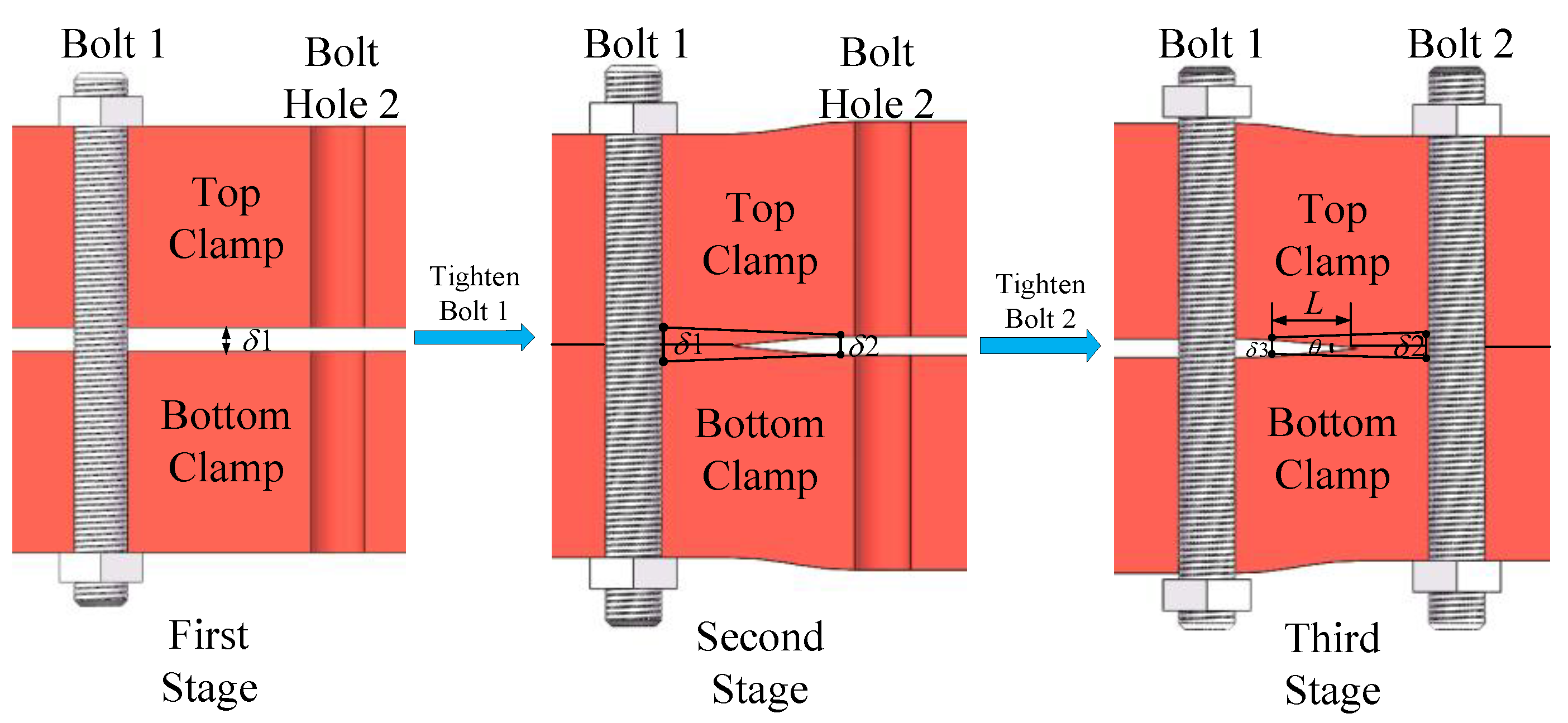
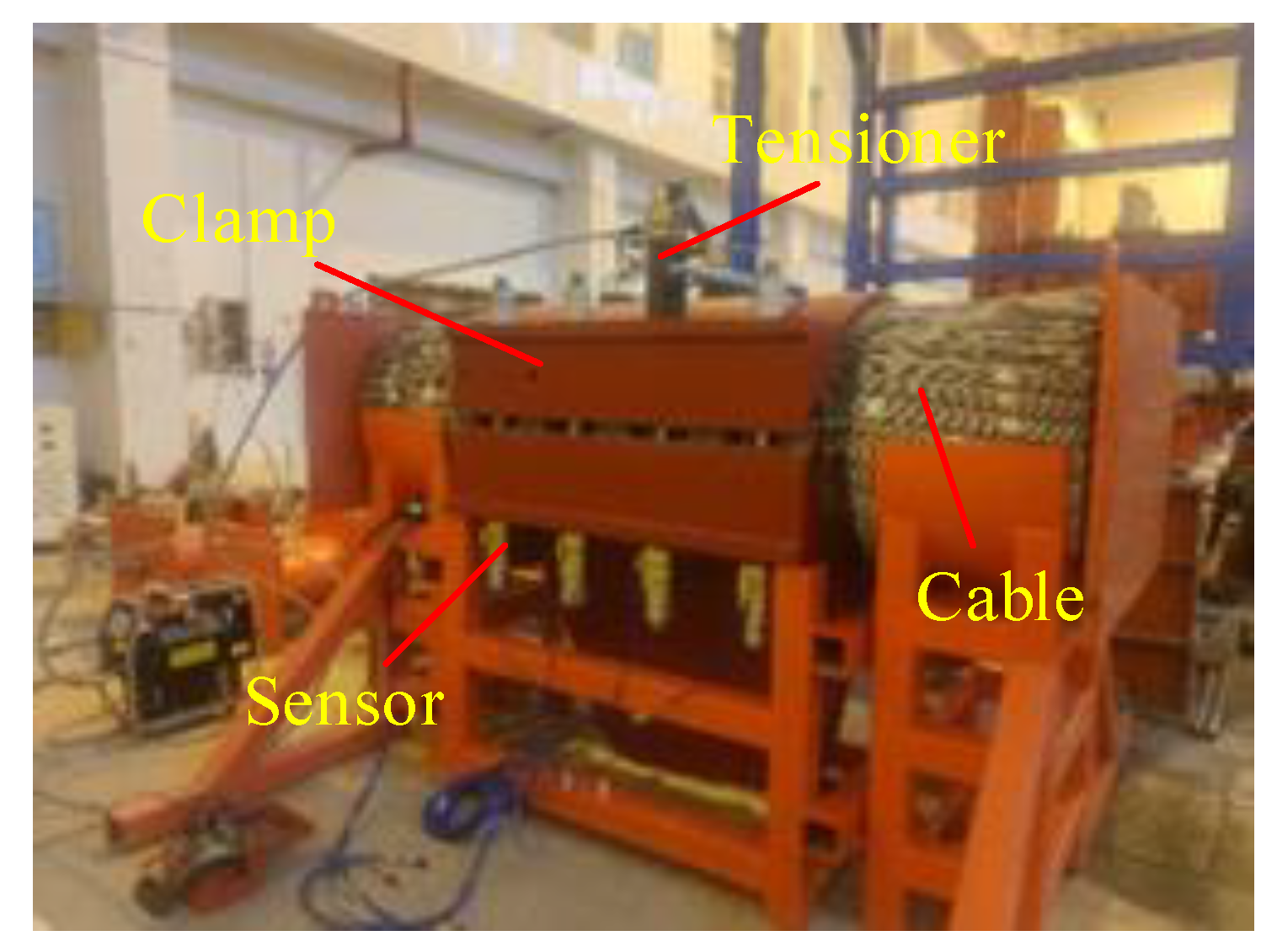
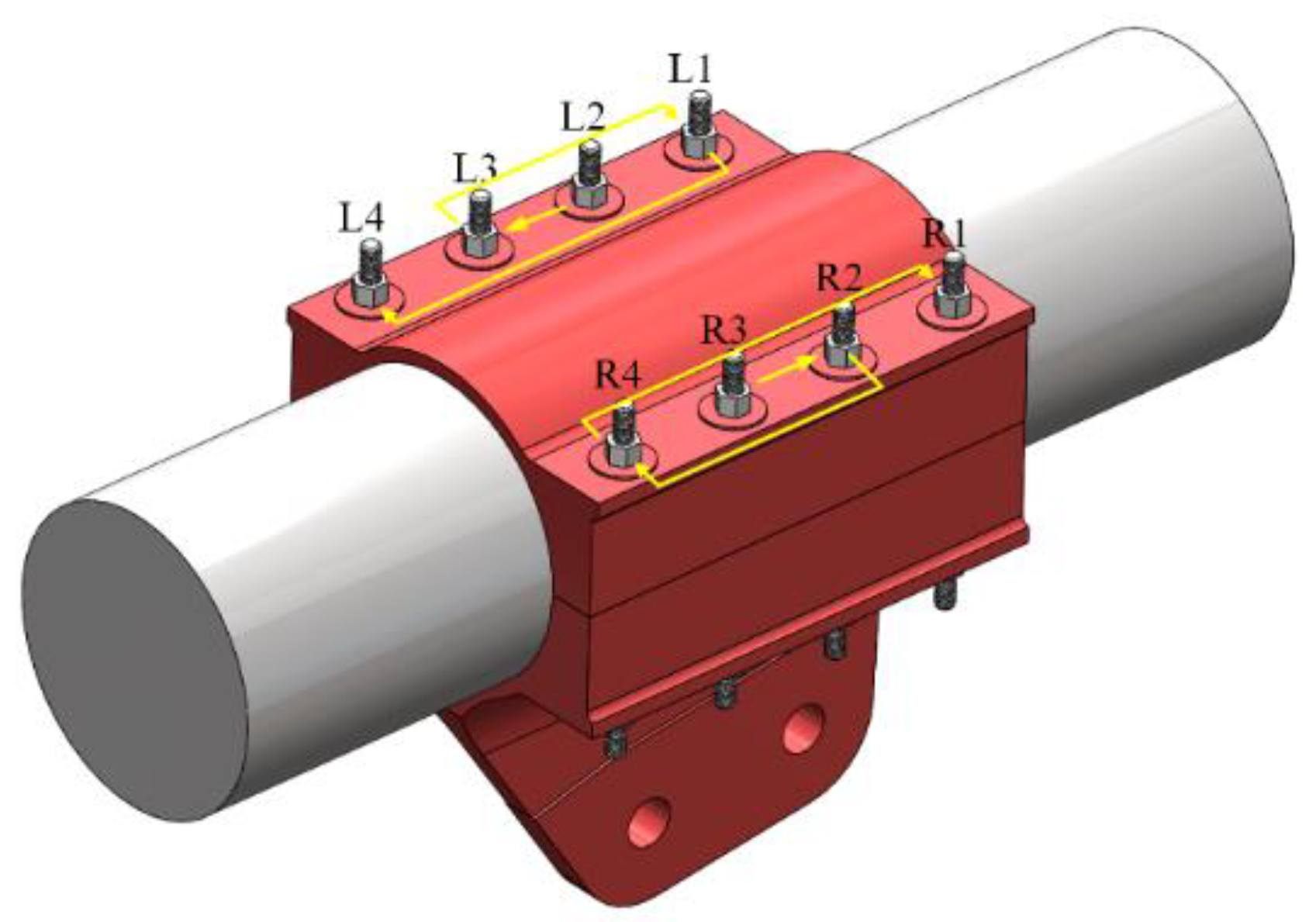
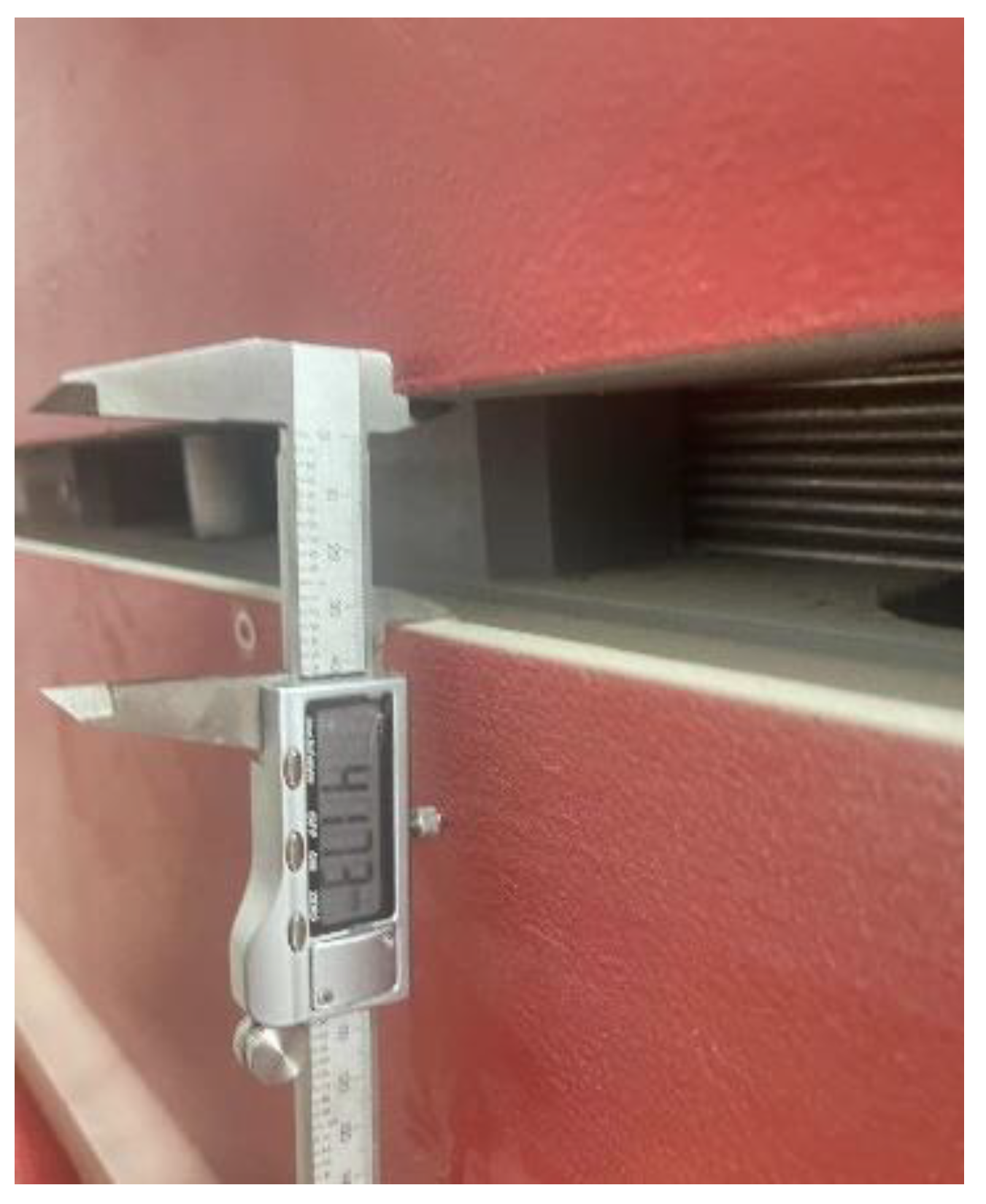
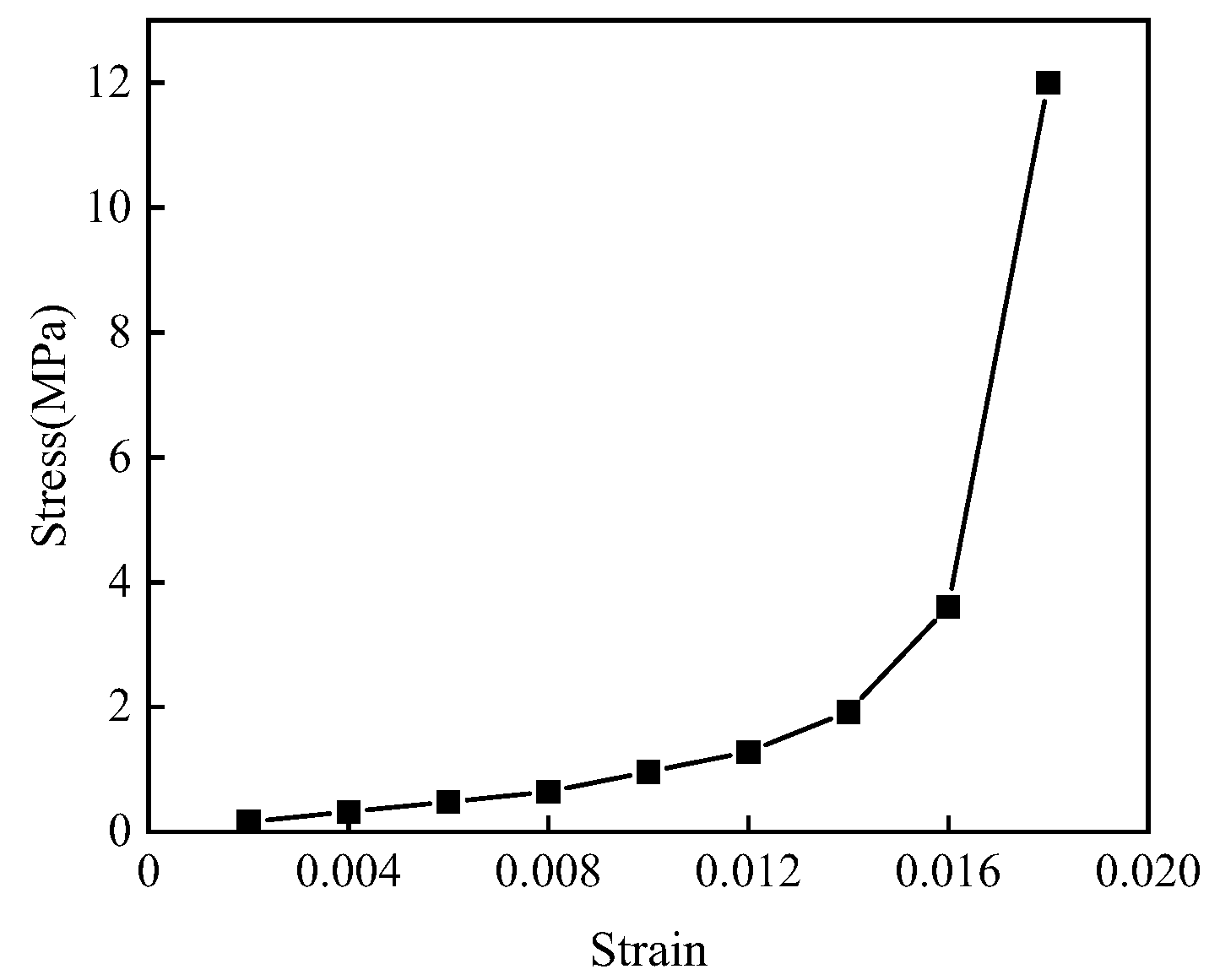
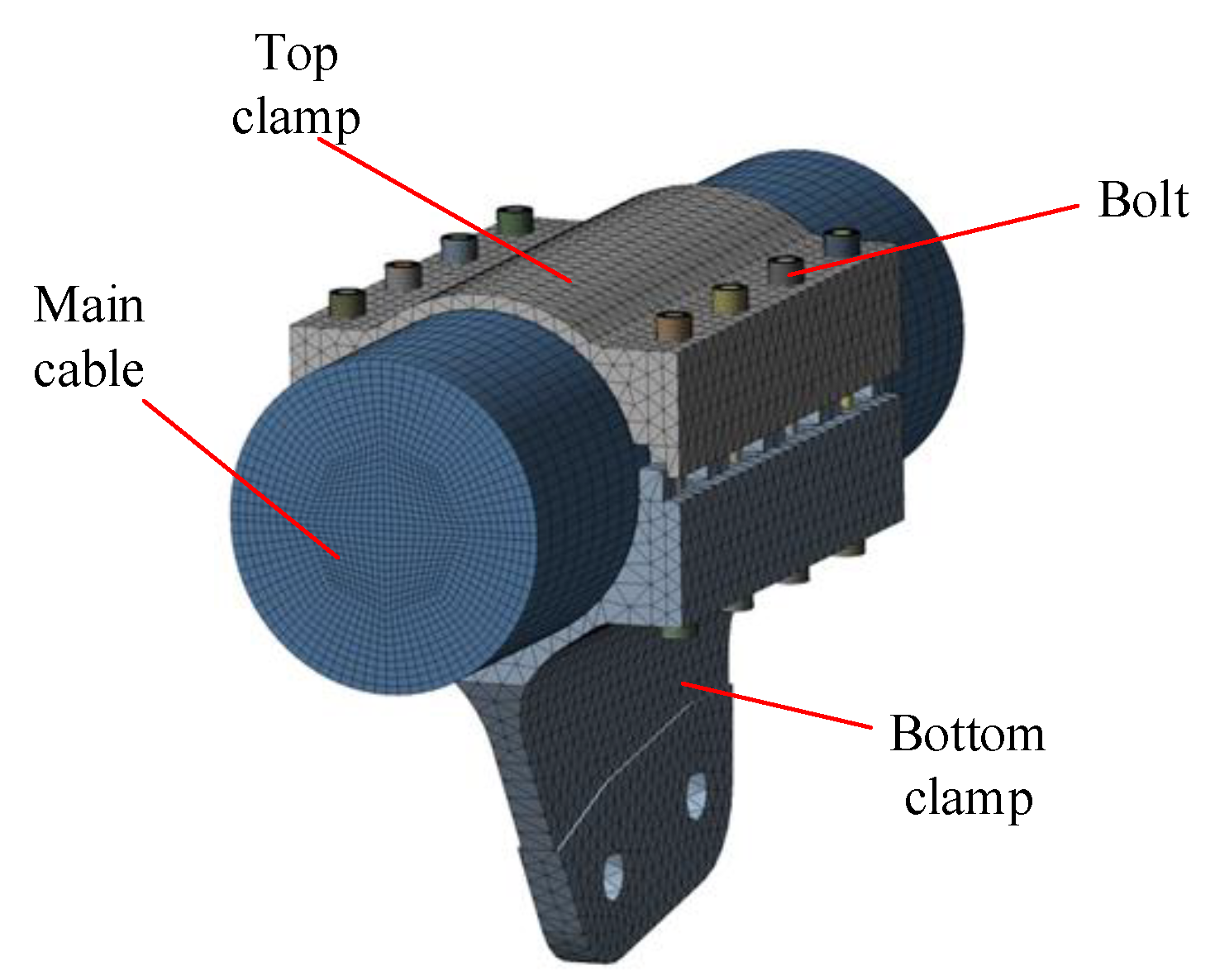

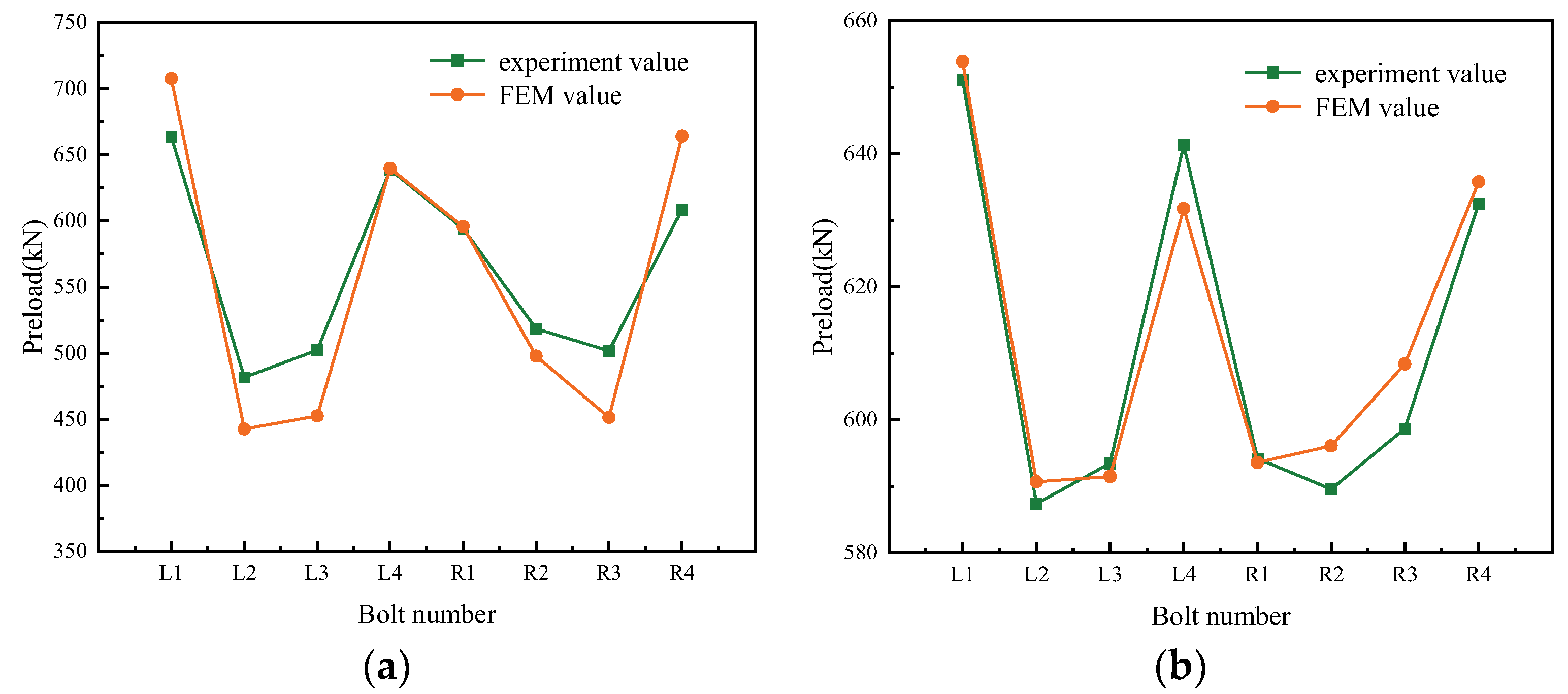


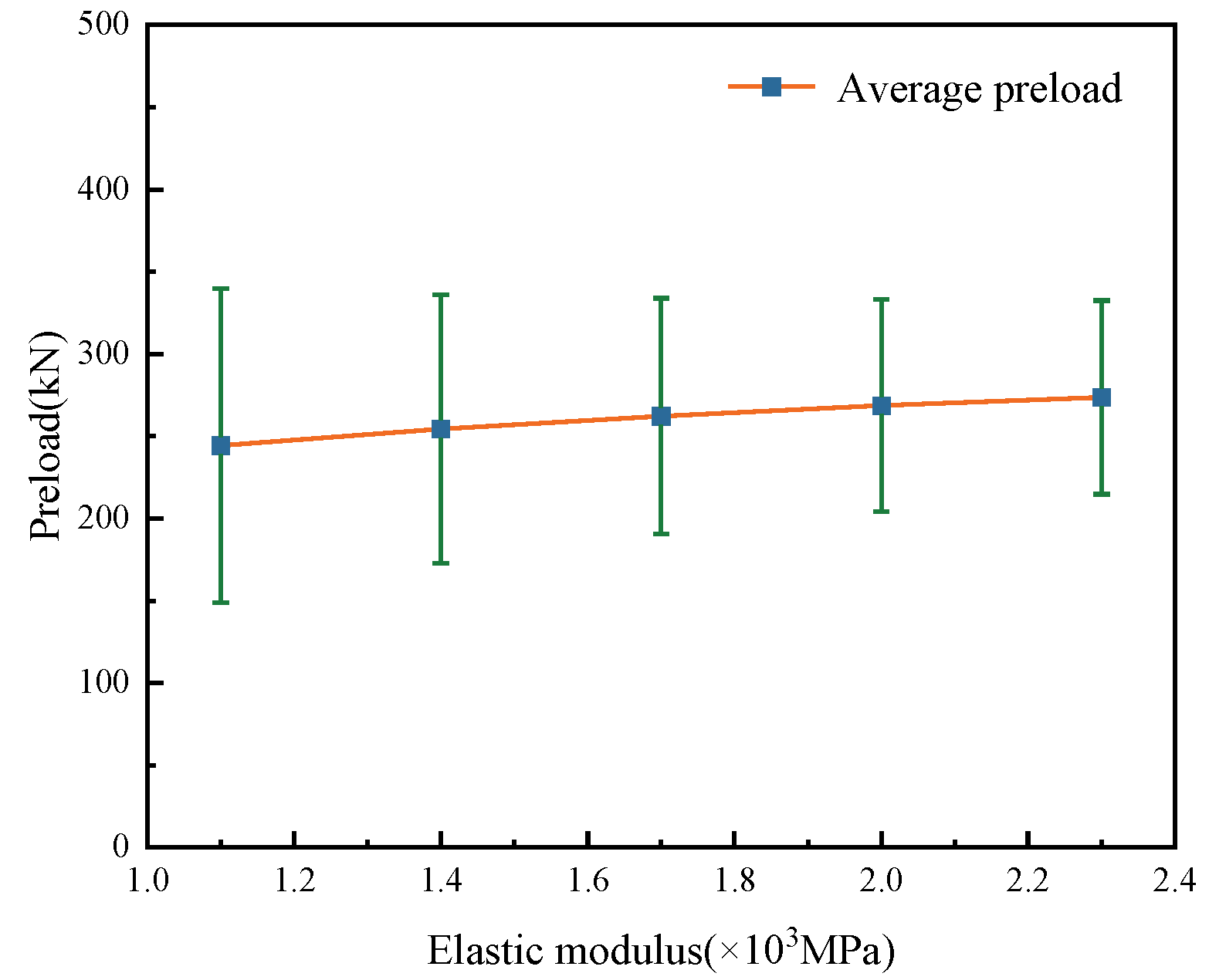



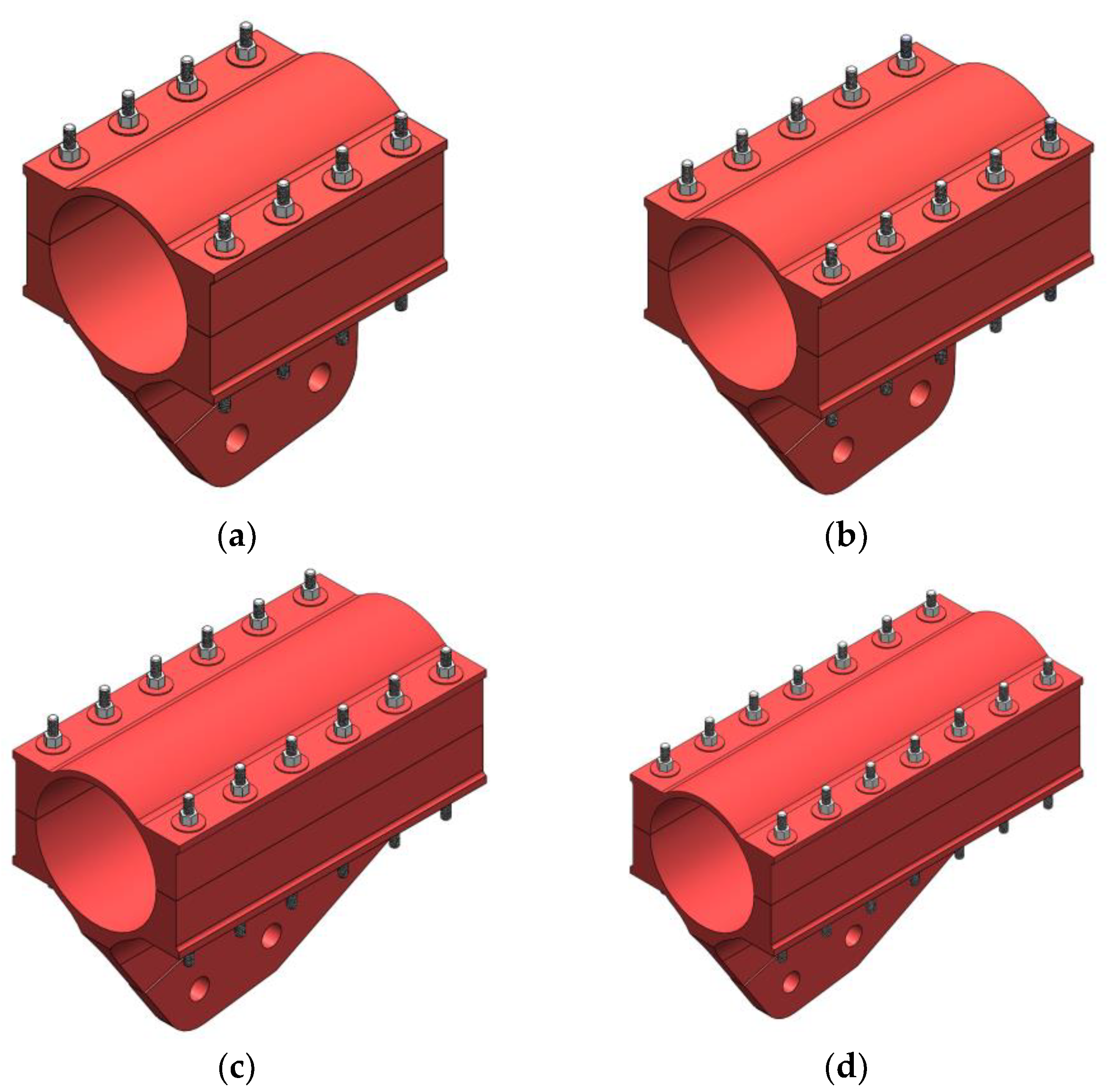
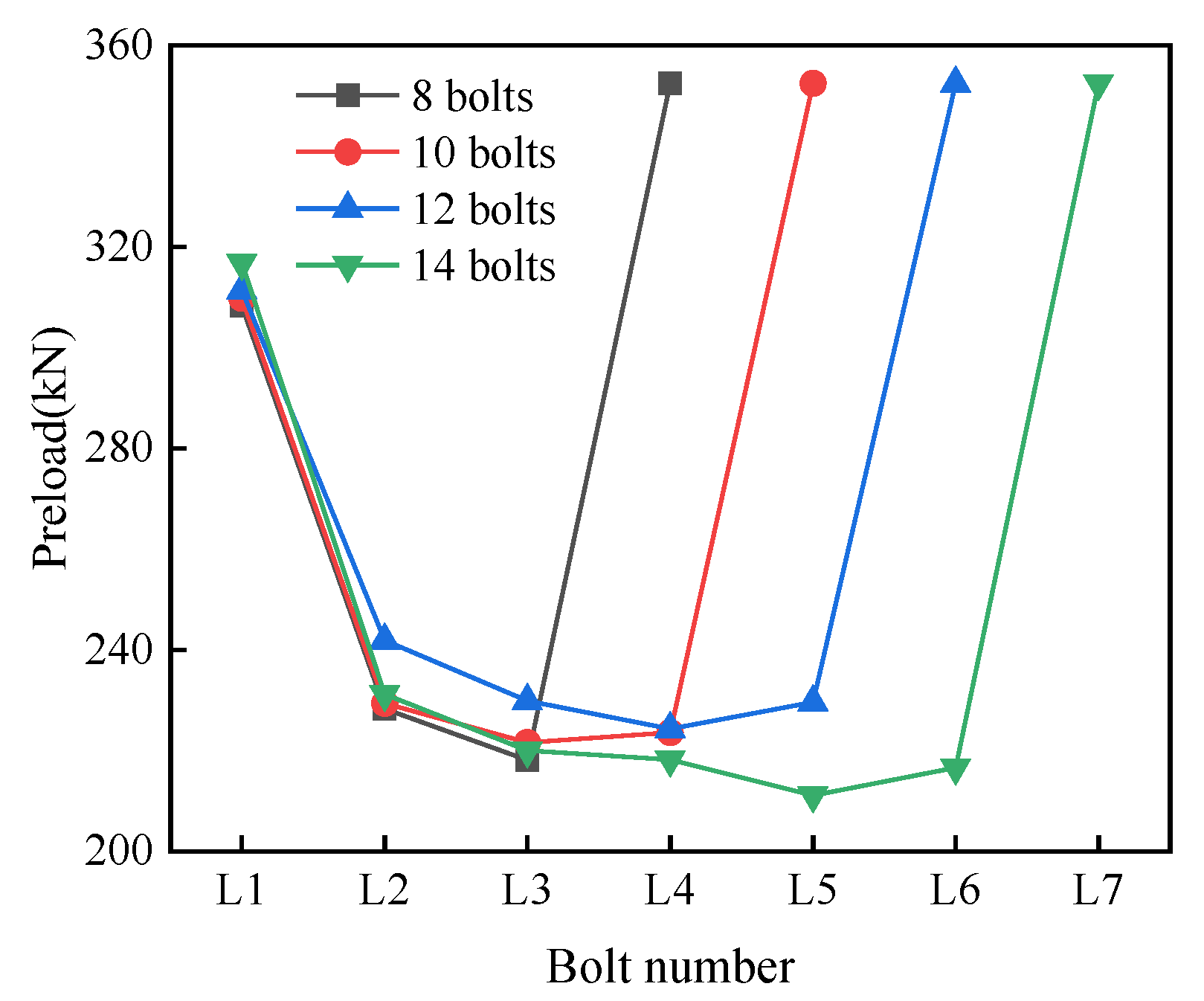

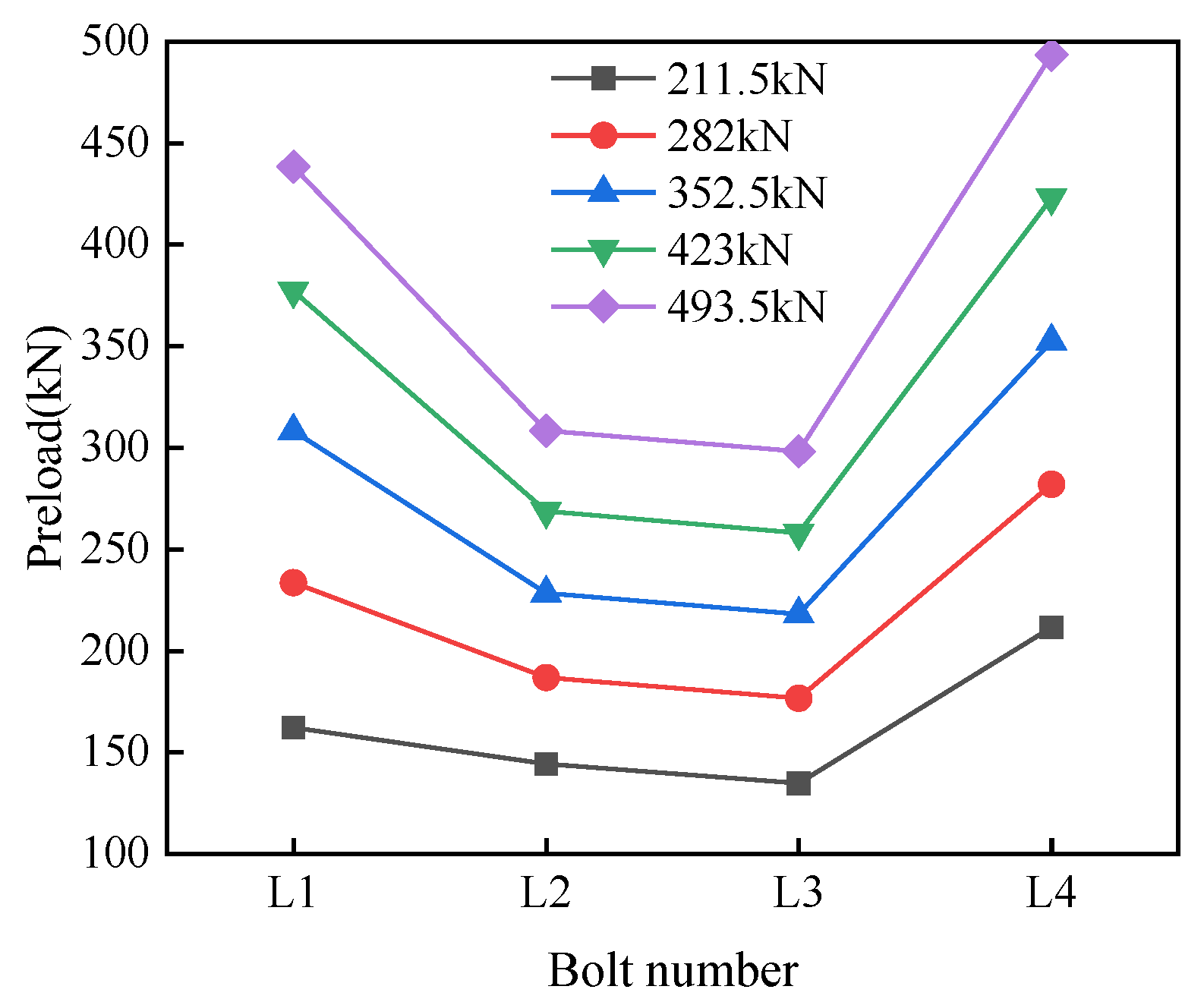
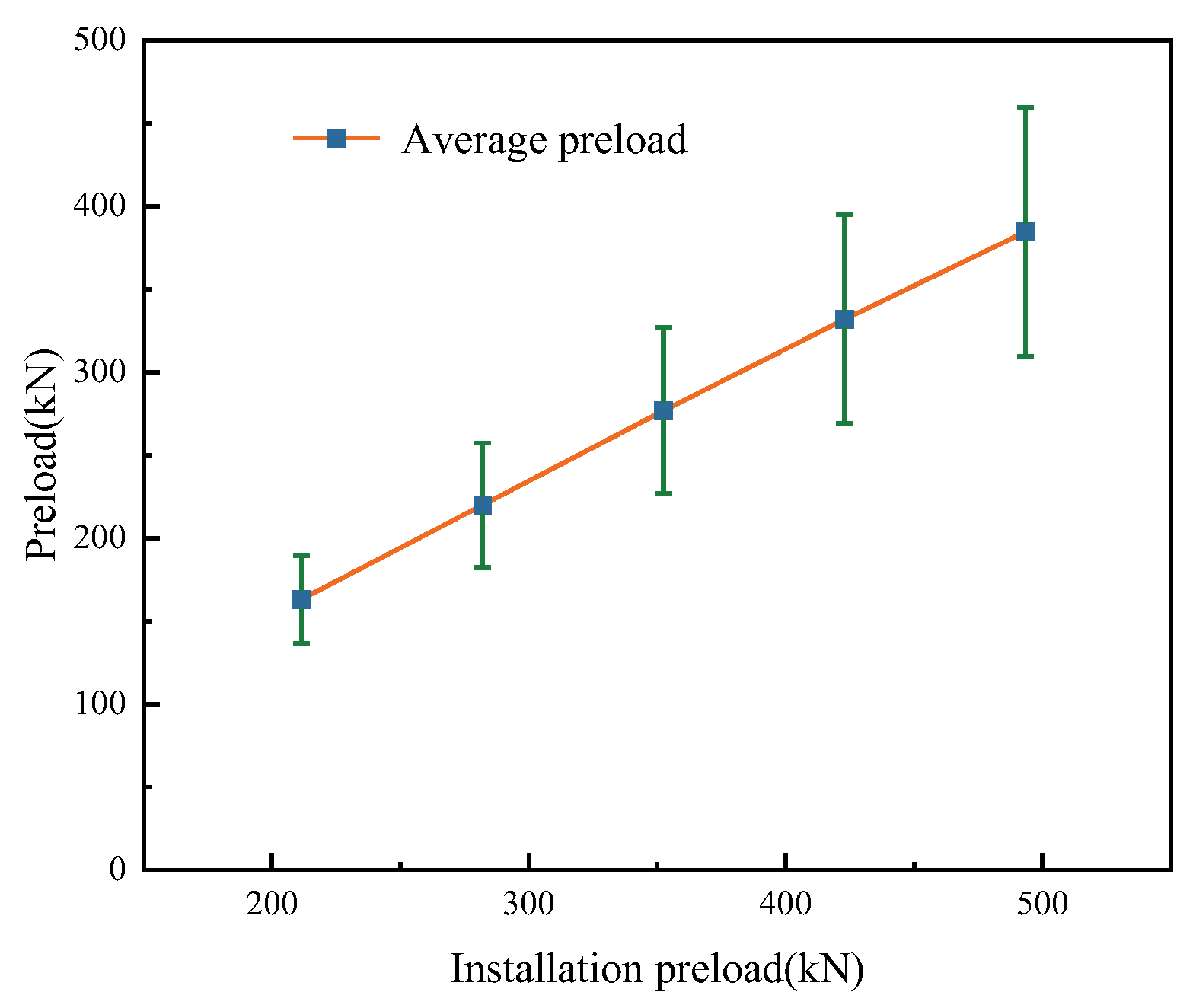

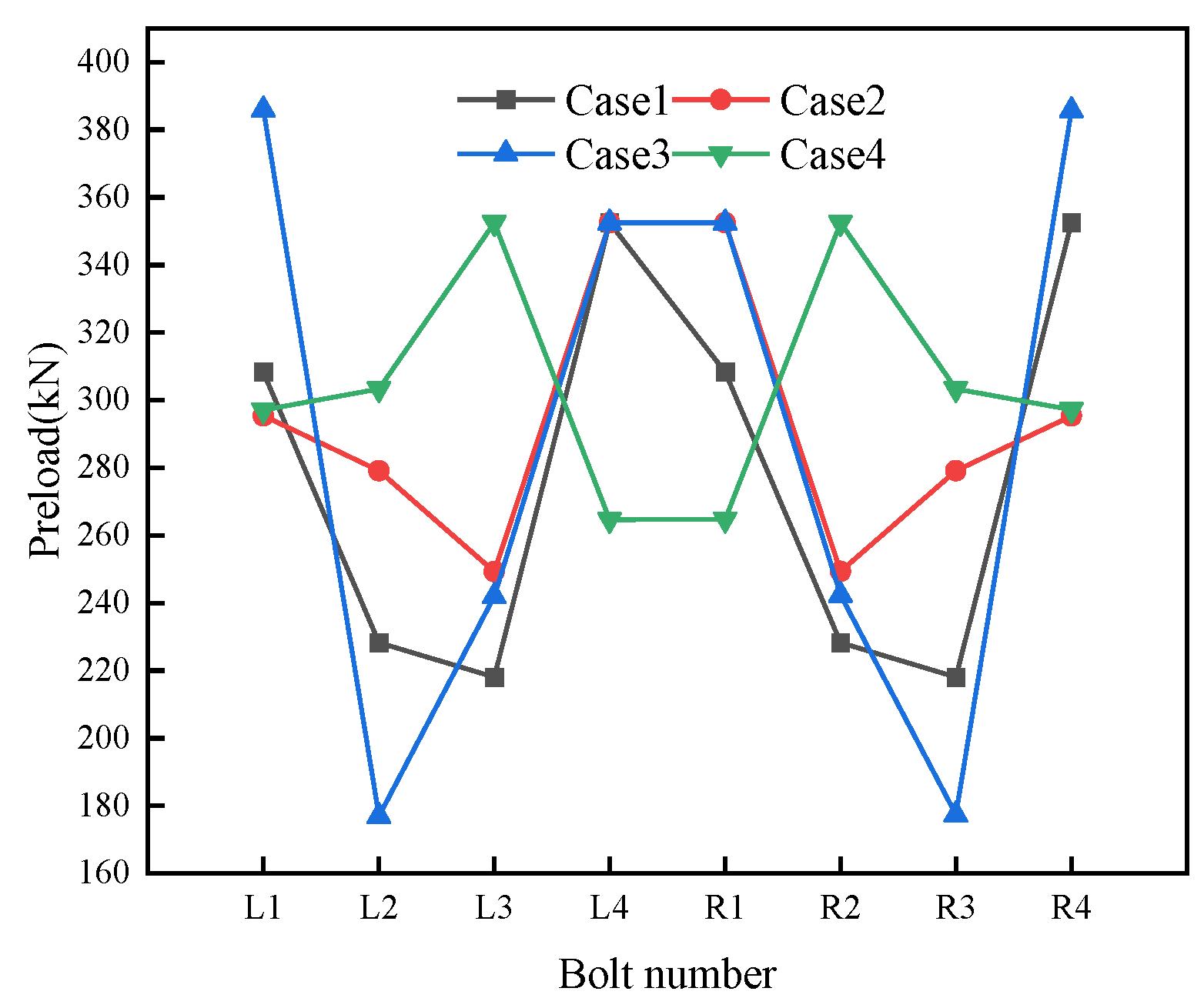

| Tightening Round | L1 Preload (kN) | L2 Preload (kN) | L3 Preload (kN) | L4 Preload (kN) | R1 Preload (kN) | R2 Preload (kN) | R3 Preload (kN) | R4 Preload (kN) | Gap Width (mm) |
|---|---|---|---|---|---|---|---|---|---|
| Round 1 | 663.8 | 481.7 | 502.4 | 638.9 | 594.3 | 518.5 | 501.8 | 608.8 | 41.7 |
| Round 2 | 651.2 | 587.4 | 593.5 | 641.3 | 594.2 | 589.6 | 598.7 | 632.5 | 41.5 |
| Elastic Modulus (MPa) | L1 (kN) | L2 (kN) | L3 (kN) | L4 (kN) | Average (kN) | Standard Deviation (kN) |
|---|---|---|---|---|---|---|
| 1.1 × 103 | 326.2 | 157.5 | 141.3 | 352.5 | 244.4 | 95.5 |
| 1.4 × 103 | 316.8 | 181.7 | 166.5 | 352.5 | 254.4 | 81.5 |
| 1.7 × 103 | 312.1 | 199.6 | 184.7 | 352.5 | 262.1 | 71.7 |
| 2.0 × 103 | 310.2 | 212.4 | 199.4 | 352.5 | 268.6 | 64.5 |
| 2.3 × 103 | 308.4 | 222.1 | 211.5 | 352.5 | 273.6 | 58.9 |
| Center Distances (mm) | L1 (kN) | L2 (kN) | L3 (kN) | L4 (kN) | Average (kN) | Standard Deviation (kN) |
|---|---|---|---|---|---|---|
| 180 | 233.8 | 138 | 137.4 | 352.5 | 215.4 | 88.3 |
| 225 | 268.4 | 187.6 | 184.5 | 352.5 | 248.3 | 69.0 |
| 270 | 291.5 | 216 | 207.8 | 352.5 | 267.0 | 59.2 |
| 315 | 308.3 | 228.3 | 218.1 | 352.5 | 276.8 | 55.9 |
| Numbers of Bolts | L1 (kN) | L2 (kN) | L3 (kN) | L4 (kN) | L5 (kN) | L6 (kN) | L7 (kN) | Average (kN) | Standard Deviation (kN) |
|---|---|---|---|---|---|---|---|---|---|
| 8 | 308.3 | 228.3 | 218.1 | 352.5 | — | — | — | 276.8 | 55.9 |
| 10 | 309.8 | 229.4 | 221.6 | 223.6 | 352.5 | — | — | 267.4 | 53.9 |
| 12 | 311.4 | 241.9 | 229.9 | 224.3 | 229.6 | 352.5 | — | 264.9 | 49.1 |
| 14 | 316.8 | 231.2 | 220 | 218.2 | 211.1 | 216.6 | 352.5 | 252.3 | 53.2 |
| Preload of Bolt Installation (kN) | L1 (kN) | L2 (kN) | L3 (kN) | L4 (kN) | Average (kN) | Standard Deviation (kN) |
|---|---|---|---|---|---|---|
| 211.5 | 162.1 | 144.2 | 134.7 | 211.5 | 163.1 | 26.5 |
| 282.0 | 233.6 | 186.8 | 176.6 | 282.0 | 219.8 | 37.5 |
| 352.5 | 308.3 | 228.3 | 218.1 | 352.5 | 276.8 | 50.0 |
| 423.0 | 377.2 | 268.8 | 258.0 | 423.0 | 331.8 | 62.9 |
| 493.5 | 438.4 | 308.4 | 298.2 | 493.5 | 384.6 | 74.9 |
| Tightening Sequence | L1 (kN) | L2 (kN) | L3 (kN) | L4 (kN) | R1 (kN) | R2 (kN) | R3 (kN) | R4 (kN) | Average (kN) | Standard Deviation (kN) |
|---|---|---|---|---|---|---|---|---|---|---|
| Case 1 | 308.3 | 228.3 | 218.1 | 352.5 | 308.3 | 228.3 | 218.1 | 352.5 | 276.8 | 52.7 |
| Case 2 | 295.5 | 279.15 | 249.25 | 352.5 | 352.5 | 249.335 | 279.135 | 295.31 | 294.1 | 37.6 |
| Case 3 | 385.9 | 177.0 | 241.975 | 352.5 | 352.5 | 242.31 | 177.41 | 385.71 | 289.4 | 83.8 |
| Case 4 | 297.15 | 303.4 | 352.5 | 264.64 | 264.79 | 352.5 | 303.34 | 297.2 | 304.4 | 31.4 |
Disclaimer/Publisher’s Note: The statements, opinions and data contained in all publications are solely those of the individual author(s) and contributor(s) and not of MDPI and/or the editor(s). MDPI and/or the editor(s) disclaim responsibility for any injury to people or property resulting from any ideas, methods, instructions or products referred to in the content. |
© 2024 by the authors. Licensee MDPI, Basel, Switzerland. This article is an open access article distributed under the terms and conditions of the Creative Commons Attribution (CC BY) license (https://creativecommons.org/licenses/by/4.0/).
Share and Cite
Mu, F.; Wang, B.; Zhou, Y.; Jing, Y.; Zhao, Y.; Luo, Z. Research on Influencing Factors of Cable Clamp Bolt Elastic Interaction in Cross-Ocean Suspension Bridges. J. Mar. Sci. Eng. 2024, 12, 1531. https://doi.org/10.3390/jmse12091531
Mu F, Wang B, Zhou Y, Jing Y, Zhao Y, Luo Z. Research on Influencing Factors of Cable Clamp Bolt Elastic Interaction in Cross-Ocean Suspension Bridges. Journal of Marine Science and Engineering. 2024; 12(9):1531. https://doi.org/10.3390/jmse12091531
Chicago/Turabian StyleMu, Fengrui, Bo Wang, Yongjun Zhou, Yuan Jing, Yu Zhao, and Zhiran Luo. 2024. "Research on Influencing Factors of Cable Clamp Bolt Elastic Interaction in Cross-Ocean Suspension Bridges" Journal of Marine Science and Engineering 12, no. 9: 1531. https://doi.org/10.3390/jmse12091531
APA StyleMu, F., Wang, B., Zhou, Y., Jing, Y., Zhao, Y., & Luo, Z. (2024). Research on Influencing Factors of Cable Clamp Bolt Elastic Interaction in Cross-Ocean Suspension Bridges. Journal of Marine Science and Engineering, 12(9), 1531. https://doi.org/10.3390/jmse12091531





